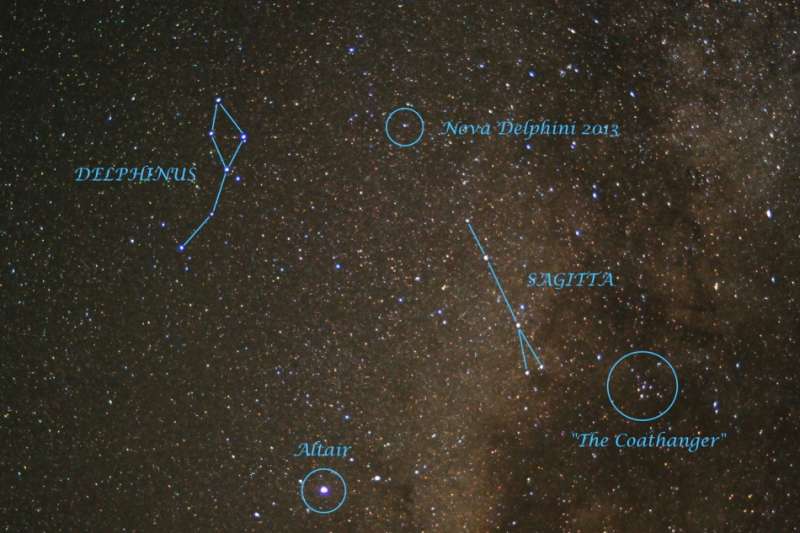Credit & Copyright: Jimmy Westlake
(Colorado
Mountain College)
Explanation:
Using a small telescope to scan the skies on August 14,
Japanese amateur astronomer Koichi Itagaki
discovered a "new" star
within the boundaries of the constellation Delphinus.
Indicated in this skyview captured on August 15 from Stagecoach,
Colorado, it is now appropriately designated Nova Delphini 2013.
Sagitta,
the Arrow, points the way to the
newcomer's location
high in the evening sky, not far from bright star Altair
and the asterism known to
northern hemisphere skygazers as the Summer Triangle.
The nova is reported to be easy
to
spot with binoculars, near the limit of naked-eye visibility
under dark skies.
In fact, previous deep sky charts do show a much fainter
known star (about 17th
magnitude) at the position of Nova Delphini,
indicating this star's apparent brightness suddenly
increased over 25,000 times.
How does a star undergo such a
cataclysmic change?
The spectrum
of Nova Delphini
indicates it
is a classical nova, an interacting binary star system in which one star
is a dense, hot
white dwarf.
Material from a cool, giant companion star
falls onto the surface of the white dwarf,
building up until it triggers a thermonuclear event.
The drastic increase in brightness and an expanding shell
of debris is the result - but
the stars are not destroyed!
Classical novae are
believed to recur when the flow of material onto the white dwarf
resumes and produces another outburst.
Gallery:
Nova Delphini 2013
1999 2000 2001 2002 2003 2004 2005 2006 2007 2008 2009 2010 2011 2012 2013 2014 2015 2016 2017 2018 2019 2020 2021 2022 2023 2024 2025 |
Январь Февраль Март Апрель Май Июнь Июль Август Сентябрь Октябрь Ноябрь Декабрь |
NASA Web Site Statements, Warnings, and Disclaimers
NASA Official: Jay Norris. Specific rights apply.
A service of: LHEA at NASA / GSFC
& Michigan Tech. U.
|
Публикации с ключевыми словами:
nova - новые звезды
Публикации со словами: nova - новые звезды | |
См. также:
Все публикации на ту же тему >> | |
